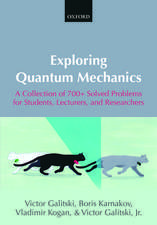Ubiquitous Quantum Structure: From Psychology to Finance
Autor Andrei Y. Khrennikoven Limba Engleză Paperback – 31 oct 2014
This book is not about quantum mechanics as a physical theory. The short review of quantum postulates is therefore mainly of historical value: quantum mechanics is just the first example of the successful application of non-Kolmogorov probabilities, the first step towards a contextual probabilistic description of natural, biological, psychological, social, economical or financial phenomena. A general contextual probabilistic model (Växjö model) is presented. It can be used for describing probabilities in both quantum and classical (statistical) mechanics as well as in the above mentioned phenomena. This model can be represented in a quantum-like way, namely, in complex and more general Hilbert spaces. In this way quantum probability is totally demystified: Born's representation of quantum probabilities by complex probability amplitudes, wave functions, is simply a special representation of this type.
| Toate formatele și edițiile | Preț | Express |
|---|---|---|
| Paperback (1) | 637.28 lei 43-57 zile | |
| Springer Berlin, Heidelberg – 31 oct 2014 | 637.28 lei 43-57 zile | |
| Hardback (1) | 641.71 lei 43-57 zile | |
| Springer Berlin, Heidelberg – 12 feb 2010 | 641.71 lei 43-57 zile |
Preț: 637.28 lei
Preț vechi: 749.73 lei
-15% Nou
Puncte Express: 956
Preț estimativ în valută:
121.96€ • 126.86$ • 100.68£
121.96€ • 126.86$ • 100.68£
Carte tipărită la comandă
Livrare economică 14-28 aprilie
Preluare comenzi: 021 569.72.76
Specificații
ISBN-13: 9783642424953
ISBN-10: 3642424953
Pagini: 232
Ilustrații: XIII, 216 p.
Dimensiuni: 155 x 235 x 12 mm
Greutate: 0.33 kg
Ediția:2010
Editura: Springer Berlin, Heidelberg
Colecția Springer
Locul publicării:Berlin, Heidelberg, Germany
ISBN-10: 3642424953
Pagini: 232
Ilustrații: XIII, 216 p.
Dimensiuni: 155 x 235 x 12 mm
Greutate: 0.33 kg
Ediția:2010
Editura: Springer Berlin, Heidelberg
Colecția Springer
Locul publicării:Berlin, Heidelberg, Germany
Public țintă
ResearchCuprins
Quantum-like Paradigm.- Classical (Kolmogorovian) and Quantum (Born) Probability.- Contextual Probabilistic Model #x2013; V#x00E4;xj#x00F6; Model.- Quantum-like Representation Algorithm #x002D; QLRA.- The Quantum-like Brain.- Experimental Tests of Quantum-like Behavior of the Mind.- Quantum-like Decision Making and Disjunction Effect.- Macroscopic Games and Quantum Logic.- Contextual Approach to Quantum-like Macroscopic Games.- Psycho-financial Model.- The Problem of Smoothness of Bohmian Trajectories.
Notă biografică
Professor Khrennikov works actively in quantum foundations concentrating his research on such fundamental problems as inter-relation of quantum and classical probability, quantum nonlocality, Bell’s inequality, interference of probabilities. He was one of the first in the world who started to apply quantum mathematics outside physics – in psychology, cognitive science, genetics, economy and finances. He published about 300 papers in the most prestigious journals in physics, mathematics, biology, psychology, finances, cognitive science. He is the author of 11 monographs on foundations of probability, quantum physics, p-adic and non-Archimedean analysis and their applications. Since 2001, Prof. Khrennikov is the director of The International Center for Mathematical Modeling in Physics and Cognitive Science, University of Vaxjo Sweden. This center has already organized 10 conferences on foundations of probability and quantum physics, workshops on quantum psychology and quantum finances.
Textul de pe ultima copertă
Quantum-like structure is present practically everywhere. Quantum-like (QL) models, i.e. models based on the mathematical formalism of quantum mechanics and its generalizations can be successfully applied to cognitive science, psychology, genetics, economics, finances, and game theory.
This book is not about quantum mechanics as a physical theory. The short review of quantum postulates is therefore mainly of historical value: quantum mechanics is just the first example of the successful application of non-Kolmogorov probabilities, the first step towards a contextual probabilistic description of natural, biological, psychological, social, economical or financial phenomena. A general contextual probabilistic model (Växjö model) is presented. It can be used for describing probabilities in both quantum and classical (statistical) mechanics as well as in the above mentioned phenomena. This model can be represented in a quantum-like way, namely, in complex and more general Hilbert spaces. In this way quantum probability is totally demystified: Born's representation of quantum probabilities by complex probability amplitudes, wave functions, is simply a special representation of this type.
This book is not about quantum mechanics as a physical theory. The short review of quantum postulates is therefore mainly of historical value: quantum mechanics is just the first example of the successful application of non-Kolmogorov probabilities, the first step towards a contextual probabilistic description of natural, biological, psychological, social, economical or financial phenomena. A general contextual probabilistic model (Växjö model) is presented. It can be used for describing probabilities in both quantum and classical (statistical) mechanics as well as in the above mentioned phenomena. This model can be represented in a quantum-like way, namely, in complex and more general Hilbert spaces. In this way quantum probability is totally demystified: Born's representation of quantum probabilities by complex probability amplitudes, wave functions, is simply a special representation of this type.
Caracteristici
Expounds a new "quantum-inspired" approach to mathematical modeling Draws attention to structural similarities in diverse fields Rich source of ideas for further study Includes supplementary material: sn.pub/extras














